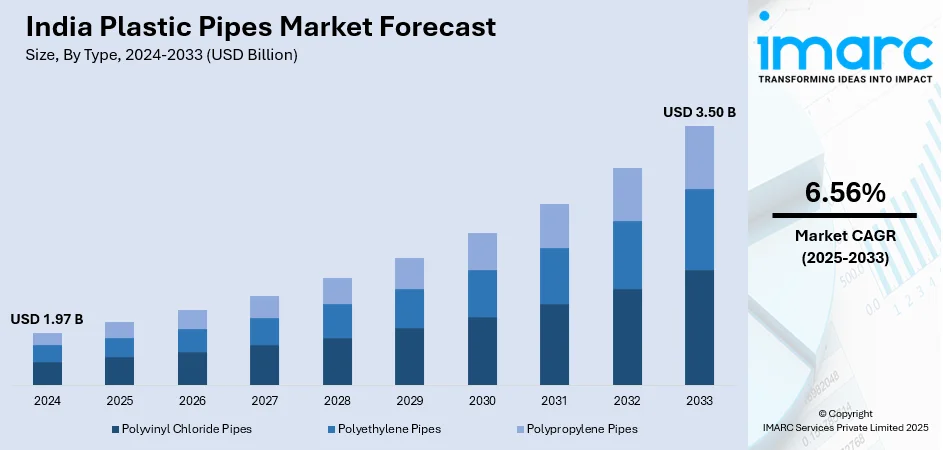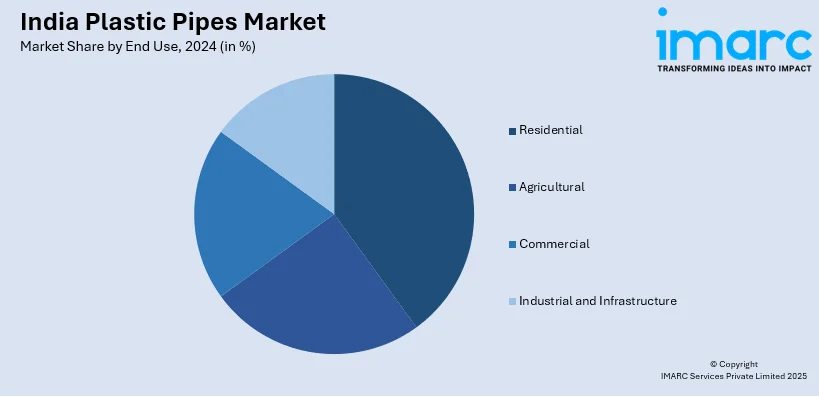
India Plastic Pipes Market Size, Share, Trends and Forecast by Type, Diameter, End Use, and Region, 2025-2033
India Plastic Pipes Market Overview:
The India plastic pipes market size reached USD 1.97 Billion in 2024. Looking forward, IMARC Group expects the market to reach USD 3.50 Billion by 2033, exhibiting a growth rate (CAGR) of 6.56% during 2025-2033. Supportive government initiatives like Jal Jeevan Mission and Smart Cities, growing infrastructure and irrigation projects, advancements in polymer technology, rising adoption of CPVC and UPVC pipes, and a booming real estate sector are propelling the market for plastic pipes in India.
|
Report Attribute
|
Key Statistics
|
|---|---|
|
Base Year
|
2024 |
|
Forecast Years
|
2025-2033
|
|
Historical Years
|
2019-2024
|
| Market Size in 2024 | USD 1.97 Billion |
| Market Forecast in 2033 | USD 3.50 Billion |
| Market Growth Rate 2025-2033 | 6.56% |
India Plastic Pipes Market Trends:
Government Initiatives and Infrastructure Development
The Indian government's ambitious infrastructure initiatives are driving significant growth in the plastic pipes market, with large-scale projects focused on water supply, sanitation, and urban development. The National Infrastructure Pipeline (NIP), launched in 2019, allocates approximately INR 102,000 crore (USD 12,421 million) across key sectors, including energy, transportation, and urban expansion. This investment underscores the government's commitment to infrastructure development, directly boosting the demand for plastic pipes used in water supply and drainage systems. Moreover, the Jal Jeevan Mission, which strives to deliver tap water to every rural household, has significantly boosted the demand for durable and affordable piping solutions, especially PVC pipes, which play a crucial role in water distribution networks. The growing focus on water conservation and management also supports the increasing adoption of plastic pipes in irrigation and municipal projects. These initiatives create a favorable market environment, fostering long-term industry growth through sustained infrastructure investments. As India continues its push for infrastructural modernization, the plastic pipes industry is poised for steady expansion, benefiting from government-driven policies and large-scale development programs.

To get more information on this market, Request Sample
Technological Advancements and Product Diversification
Technological advancements and product diversification are key drivers shaping the growth of the Indian plastic pipes market. Innovations in manufacturing, such as enhanced extrusion technologies, have significantly improved the strength, chemical resistance, and longevity of plastic pipes, making them more reliable for diverse applications. To meet the growing demand across sectors like agriculture, construction, and infrastructure, manufacturers are expanding their product offerings, introducing pipes of varying sizes, materials, and functionalities. The increasing preference for PVC and High-Density Polyethylene (HDPE) pipes highlights this trend, with HDPE pipes gaining traction due to their exceptional durability, flexibility, and suitability for both underground and above-ground installations. Additionally, the industry's growing emphasis on sustainability has led to the adoption of eco-friendly materials and production processes, aligning with global environmental initiatives. Compliance with stringent regulatory standards further ensures the delivery of high-performance and reliable piping solutions. As innovation continues to drive product evolution, the Indian plastic pipes market is poised for sustained growth, catering to the expanding demands of modern infrastructure and environmental sustainability.
India Plastic Pipes Market Segmentation:
IMARC Group provides an analysis of the key trends in each segment of the market, along with forecasts at the region/country level for 2025-2033. Our report has categorized the market based on type, diameter, and end use.
Type Insights:
- Polyvinyl Chloride Pipes
- Polyethylene Pipes
- Polypropylene Pipes
The report has provided a detailed breakup and analysis of the market based on the type. This includes polyvinyl chloride pipes, polyethylene pipes, and polypropylene pipes.
Diameter Insights:
- <50 mm
- 50-100 mm
- 100-200 mm
- 200-400 mm
- 400-700 mm
- >700 mm
The report has provided a detailed breakup and analysis of the market based on the diameter. This includes <50mm, 50-100mm, 100-200mm, 200-400mm, 400-700mm, and >700mm.
End Use Insights:

- Residential
- Agricultural
- Commercial
- Industrial and Infrastructure
A detailed breakup and analysis of the market based on the end use have also been provided in the report. This includes residential, agricultural, commercial, and industrial and infrastructure.
Regional Insights:
- North India
- South India
- East India
- West India
The report has also provided a comprehensive analysis of all the major regional markets, which include North India, South India, East India, and West India.
Competitive Landscape:
The market research report has also provided a comprehensive analysis of the competitive landscape. Competitive analysis such as market structure, key player positioning, top winning strategies, competitive dashboard, and company evaluation quadrant has been covered in the report. Also, detailed profiles of all major companies have been provided.
India Plastic Pipes Market News:
- March 2025: Supreme Industries signed a memorandum of understanding to acquire Wavin Industries' pipes and fittings business for $30 million (approximately ₹262 crores). Wavin India, a subsidiary of the Orbia Group, produces piping systems in India under the 'Wavin' brand.
- June 2024: Rollepaal established an exclusive agreement with Sintex, a subsidiary of the Welspun World conglomerate in India. The arrangement offers Sintex with RBlue extrusion lines for PVCO pipes, which are designed to increase efficiency and productivity in the production of high-quality PVCO pipes for potable water applications while lowering production costs.
- March 2024: Sintex-BAPL invested up to Rs 2,355 crores to set up manufacturing facilities in Telangana, Odisha, Madhya Pradesh, and Jammu & Kashmir. The company's goal is to serve the expanding water storage and distribution market, which is predicted to reach Rs 65,000 crores in 2030 for plastic pipes.
India Plastic Pipes Market Report Coverage:
| Report Features | Details |
|---|---|
| Base Year of the Analysis | 2024 |
| Historical Period | 2019-2024 |
| Forecast Period | 2025-2033 |
| Units | Billion USD |
| Scope of the Report | Exploration of Historical Trends and Market Outlook, Industry Catalysts and Challenges, Segment-Wise Historical and Future Market Assessment:
|
| Types Covered | Polyvinyl Chloride Pipes, Polyethylene Pipes, Polypropylene Pipes |
| Diameters Covered | <50mm, 50-100mm, 100-200mm, 200-400mm, 400-700mm, >700mm |
| End Uses Covered | Residential, Agricultural, Commercial, Industrial and Infrastructure |
| Regions Covered | North India, South India, East India, West India |
| Customization Scope | 10% Free Customization |
| Post-Sale Analyst Support | 10-12 Weeks |
| Delivery Format | PDF and Excel through Email (We can also provide the editable version of the report in PPT/Word format on special request) |
Key Benefits for Stakeholders:
- IMARC’s industry report offers a comprehensive quantitative analysis of various market segments, historical and current market trends, market forecasts, and dynamics of the India plastic pipes market from 2019-2033.
- The research report provides the latest information on the market drivers, challenges, and opportunities in the India plastic pipes market.
- Porter's five forces analysis assist stakeholders in assessing the impact of new entrants, competitive rivalry, supplier power, buyer power, and the threat of substitution. It helps stakeholders to analyze the level of competition within the India plastic pipes industry and its attractiveness.
- Competitive landscape allows stakeholders to understand their competitive environment and provides an insight into the current positions of key players in the market.
Key Questions Answered in This Report
The plastic pipes market in India was valued at USD 1.97 Billion in 2024.
The India plastic pipes market is projected to exhibit a CAGR of 6.56% during 2025-2033, reaching a value of USD 3.50 Billion by 2033.
The market is driven by growing construction activity, preference for lightweight materials, and demand for quicker plumbing installations. Their ease of handling, low maintenance, and suitability across climates contribute to rising adoption. As small builders and large contractors alike seek scalable piping solutions, plastic pipes are becoming standard in both new builds and retrofits.
Need more help?
- Speak to our experienced analysts for insights on the current market scenarios.
- Include additional segments and countries to customize the report as per your requirement.
- Gain an unparalleled competitive advantage in your domain by understanding how to utilize the report and positively impacting your operations and revenue.
- For further assistance, please connect with our analysts.
 Request Customization
Request Customization
 Speak to an Analyst
Speak to an Analyst
 Request Brochure
Request Brochure
 Inquire Before Buying
Inquire Before Buying




.webp)




.webp)












